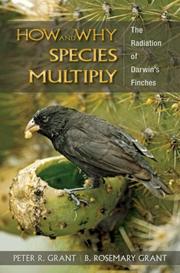| Listing 1 - 10 of 10 |
Sort by
|
Book
ISBN: 9788822260499 882226049X Year: 2010 Volume: 1 Publisher: Firenze : L.S. Olschki,
Abstract | Keywords | Export | Availability | Bookmark
 Loading...
Loading...Choose an application
- Reference Manager
- EndNote
- RefWorks (Direct export to RefWorks)
Finches --- Mockingbirds --- Flies --- Evolution (Biology) --- Evolution (Biologie) --- Evolution. --- Evolution --- Finches - Evolution --- Mockingbirds - Evolution --- Flies - Evolution
Book
ISBN: 0691149992 9780691149998 Year: 2011 Publisher: Princeton (N.J.): Princeton university press,
Abstract | Keywords | Export | Availability | Bookmark
 Loading...
Loading...Choose an application
- Reference Manager
- EndNote
- RefWorks (Direct export to RefWorks)

ISBN: 9780691133607 0691133603 Year: 2008 Publisher: Princeton (N.J.) : Princeton university press,
Abstract | Keywords | Export | Availability | Bookmark
 Loading...
Loading...Choose an application
- Reference Manager
- EndNote
- RefWorks (Direct export to RefWorks)
Finches --- Finches --- Adaptation --- Evolution

ISBN: 0226305910 Year: 1989 Publisher: Chicago, Ill. University of Chicago Press
Abstract | Keywords | Export | Availability | Bookmark
 Loading...
Loading...Choose an application
- Reference Manager
- EndNote
- RefWorks (Direct export to RefWorks)
Animal genetics. Animal evolution --- Birds --- Galápagos Islands
Book
ISBN: 1400851300 Year: 2014 Publisher: Princeton, NJ : Princeton University Press,
Abstract | Keywords | Export | Availability | Bookmark
 Loading...
Loading...Choose an application
- Reference Manager
- EndNote
- RefWorks (Direct export to RefWorks)
Renowned evolutionary biologists Peter and Rosemary Grant have produced landmark studies of the Galápagos finches first made famous by Charles Darwin. In How and Why Species Multiply, they offered a complete evolutionary history of Darwin's finches since their origin almost three million years ago. Now, in their richly illustrated new book, 40 Years of Evolution, the authors turn their attention to events taking place on a contemporary scale. By continuously tracking finch populations over a period of four decades, they uncover the causes and consequences of significant events leading to evolutionary changes in species.The authors used a vast and unparalleled range of ecological, behavioral, and genetic data--including song recordings, DNA analyses, and feeding and breeding behavior--to measure changes in finch populations on the small island of Daphne Major in the Galápagos archipelago. They find that natural selection happens repeatedly, that finches hybridize and exchange genes rarely, and that they compete for scarce food in times of drought, with the remarkable result that the finch populations today differ significantly in average beak size and shape from those of forty years ago. The authors' most spectacular discovery is the initiation and establishment of a new lineage that now behaves as a new species, differing from others in size, song, and other characteristics. The authors emphasize the immeasurable value of continuous long-term studies of natural populations and of critical opportunities for detecting and understanding rare but significant events.By following the fates of finches for several generations, 40 Years of Evolution offers unparalleled insights into ecological and evolutionary changes in natural environments.
Bird populations --- Birds --- Ground finches --- Evolution
Book
ISBN: 1400837944 Year: 2020 Publisher: Princeton, NJ : Princeton University Press,
Abstract | Keywords | Export | Availability | Bookmark
 Loading...
Loading...Choose an application
- Reference Manager
- EndNote
- RefWorks (Direct export to RefWorks)
Charles Darwin's experiences in the Galápagos Islands in 1835 helped to guide his thoughts toward a revolutionary theory: that species were not fixed but diversified from their ancestors over many generations, and that the driving mechanism of evolutionary change was natural selection. In this concise, accessible book, Peter and Rosemary Grant explain what we have learned about the origin and evolution of new species through the study of the finches made famous by that great scientist: Darwin's finches. Drawing upon their unique observations of finch evolution over a thirty-four-year period, the Grants trace the evolutionary history of fourteen different species from a shared ancestor three million years ago. They show how repeated cycles of speciation involved adaptive change through natural selection on beak size and shape, and divergence in songs. They explain other factors that drive finch evolution, including geographical isolation, which has kept the Galápagos relatively free of competitors and predators; climate change and an increase in the number of islands over the last three million years, which enhanced opportunities for speciation; and flexibility in the early learning of feeding skills, which helped species to exploit new food resources. Throughout, the Grants show how the laboratory tools of developmental biology and molecular genetics can be combined with observations and experiments on birds in the field to gain deeper insights into why the world is so biologically rich and diverse. Written by two preeminent evolutionary biologists, How and Why Species Multiply helps to answer fundamental questions about evolution--in the Galápagos and throughout the world.
Finches --- Evolution --- Adaptation --- Adaptation, adaptive. --- Alleles. --- Allopatry (geographical isolation). --- Arthropods. --- Camarhynchus, tree finches. --- Certhidea olivacea, warbler finch. --- Class, taxonomic. --- Coexistence. --- Diet of finches: arthropods. --- Diversity. --- Environmental conditions, opportunities. --- Extinction. --- Feeding behavior. --- Fitness: of hybrids. --- Geospiza fortis, medium ground finch. --- Human activities. --- Hybridization. --- Immigration. --- Key traits. --- Lack, David. --- Molecular genetics. --- Natural selection. --- Platyspiza crassirostris, vegetarian finch. --- Reinforcement. --- Variation: genetic. --- selection on.
Book
ISBN: 140083709X Year: 2010 Publisher: Princeton, New Jersey ; Oxford : Princeton University Press,
Abstract | Keywords | Export | Availability | Bookmark
 Loading...
Loading...Choose an application
- Reference Manager
- EndNote
- RefWorks (Direct export to RefWorks)
Evolutionary biology has witnessed breathtaking advances in recent years. Some of its most exciting insights have come from the crossover of disciplines as varied as paleontology, molecular biology, ecology, and genetics. This book brings together many of today's pioneers in evolutionary biology to describe the latest advances and explain why a cross-disciplinary and integrated approach to research questions is so essential. Contributors discuss the origins of biological diversity, mechanisms of evolutionary change at the molecular and developmental levels, morphology and behavior, and the ecology of adaptive radiations and speciation. They highlight the mutual dependence of organisms and their environments, and reveal the different strategies today's researchers are using in the field and laboratory to explore this interdependence. Peter and Rosemary Grant--renowned for their influential work on Darwin's finches in the Galápagos--provide concise introductions to each section and identify the key questions future research needs to address. In addition to the editors, the contributors are Myra Awodey, Christopher N. Balakrishnan, Rowan D. H. Barrett, May R. Berenbaum, Paul M. Brakefield, Philip J. Currie, Scott V. Edwards, Douglas J. Emlen, Joshua B. Gross, Hopi E. Hoekstra, Richard Hudson, David Jablonski, David T. Johnston, Mathieu Joron, David Kingsley, Andrew H. Knoll, Mimi A. R. Koehl, June Y. Lee, Jonathan B. Losos, Isabel Santos Magalhaes, Albert B. Phillimore, Trevor Price, Dolph Schluter, Ole Seehausen, Clifford J. Tabin, John N. Thompson, and David B. Wake.
Evolution (Biology) --- Angraecum striatum. --- Barombi Mbo lake. --- Beipiaosaurus inexpectus. --- Bicyclus anynana. --- Caudipteryx dongi. --- Confuciusornis. --- Darwinian evolution. --- Deinonychus. --- Fisherian selection. --- Gasterosteus. --- Greya mitellae. --- Hawaii. --- Herrerasaurus. --- Heucherina. --- adaptive loss. --- adaptive radiation. --- adaptive walk. --- allospecies. --- amber fossils. --- antagonism. --- ascertainment bias. --- beetle horns. --- behavior. --- behavioral ecology. --- biodiversity problem. --- biomechanics. --- biotic drift. --- bounded diffusion. --- bryozoans. --- catastrophism. --- coalescent model. --- colonization. --- commensalism. --- convergent evolution. --- cultural inheritance. --- ecogenomics. --- ecological diversity. --- ecological factors. --- epistasis. --- extended phenotype. --- field experiments. --- field studies. --- freshwater fish. --- gene expression analysis. --- genetic mapping. --- genomics era. --- habitat effects. --- host shifts. --- hybridization. --- hypomorphic mutations. --- imaginal discs.
Book
ISBN: 9781400837946 Year: 2020 Publisher: Princeton, NJ
Abstract | Keywords | Export | Availability | Bookmark
 Loading...
Loading...Choose an application
- Reference Manager
- EndNote
- RefWorks (Direct export to RefWorks)
Book
ISBN: 9781400851300 Year: 2014 Publisher: Princeton, NJ
Abstract | Keywords | Export | Availability | Bookmark
 Loading...
Loading...Choose an application
- Reference Manager
- EndNote
- RefWorks (Direct export to RefWorks)
Book

ISBN: 9781400837090 Year: 2022 Publisher: Princeton, NJ
Abstract | Keywords | Export | Availability | Bookmark
 Loading...
Loading...Choose an application
- Reference Manager
- EndNote
- RefWorks (Direct export to RefWorks)
| Listing 1 - 10 of 10 |
Sort by
|

 Search
Search Feedback
Feedback About
About Help
Help News
News